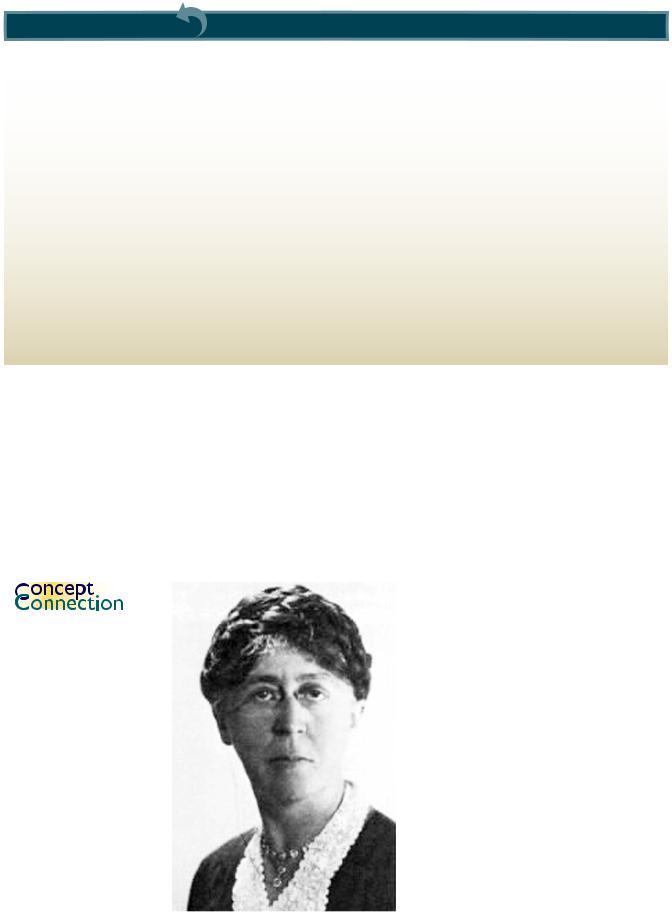

40 |
Part 1 Introduction to Management |
Remember This
•The study of modern management began in the late nineteenth century with the classical perspective, which took a rational, scientifi c approach to management
and sought to make organizations e cient operating machines.
•Scientific management is a subfi eld of the classical perspective that emphasizes scientifically determined changes in management practices as the solution to improving labor productivity.
•Frederick Winslow Taylor is known as the father of scientific management.
•Scientifi c management is considered one of the most signifi cant innovations infl uencing modern management.
•Some supermarket chains are using computerized systems based on scientifi c management principles to schedule employees for maximum e ciency.
•Another subfi eld of the classical perspective is the bureaucratic organizations approach, which emphasizes management on an impersonal, rational basis through elements such as clearly defi ned authority and responsibility, formal record-keeping, and separation of management and ownership.
•Max Weber introduced most of the concepts on bureaucratic organizations.
•Administrative principles is a subfi eld of the classical perspective that focuses on the total organization rather than the individual worker and delineates the management functions of planning, organizing, commanding, coordinating, and controlling.
•Henri Fayol, a major contributor to the administrative principles approach, outlined 14 general principles of management, several of which are a part of management philosophy today.
Humanistic Perspective
The humanistic perspective on management emphasized the importance of understanding human behaviors, needs, and attitudes in the workplace as well as social interactions and group processes.21 There are three primary subfields based on the humanistic perspective: the human relations movement, the human resources perspective, and the behavioral sciences approach.
Mary Parker Follett (1868–1933). Follett was an early advocate of the humanistic perspective on management. Her emphasis on worker participation and shared goals among managers was embraced by many businesspeople of the day and has been recently “rediscovered” by corporate America.
Mary Parker Follette Foundation and Reading University, UK
Early Advocates
Two early advocates of a more humanistic approach were Mary Parker Follett and Chester Barnard. Mary Parker Follett (1868–1933) was trained in philosophy and political science at what today is Radcli e College. She applied herself in many fields, including social psychology and management. She wrote of the importance of common superordinate goals for reducing confl ict in organizations.22 Her work was popular with businesspeople of her day but was often overlooked by management scholars.23 Follett’s ideas served as a contrast to scientific management and are re-emerging as applicable for modern managers dealing with rapid changes in today’s global environment. Her approach to leadership stressed the importance of people rather than engineering techniques. She o ered the pithy admonition, “Don’t hug your blueprints,” and analyzed the
Copyright 2011 Cengage Learning. All Rights Reserved. May not be copied, scanned, or duplicated, in whole or in part. Due to electronic rights, some third party content may be suppressed from the eBook and/or eChapter(s). Editorial review has deemed that any suppressed content does not materially affect the overall learning experience. Cengage Learning reserves the right to remove additional content at any time if subsequent rights restrictions require it.

Chapter 2 The Evolution of Management Thinking |
41 |
dynamics of management-organization interactions. Follett addressed issues that are timely today, such as ethics, power, and how to lead in a way that encourages employees to give their best. The concepts of empowerment, facilitating rather than controlling employees, and allowing employees to act depending on the authority of the situation opened new areas for theoretical study by Chester Barnard and others.24
Chester I. Barnard (1886–1961) studied economics at Har- |
|
|
||
vard but failed to receive a degree because he lacked a course in |
|
|
||
laboratory science. He went to work in the statistical department |
|
|
||
of AT&T and in 1927 became president of New Jersey Bell. One |
|
|
||
of Barnard’s significant contributions was the concept of the in- |
|
|
||
formal organization. The informal organization occurs in all formal |
|
|
||
organizations and includes cliques and naturally occurring social |
|
|
||
groupings. Barnard argued that organizations are not machines |
|
|
||
and stressed that informal relationships are powerful forces that |
|
|
||
can help the organization if properly managed. Another signifi- |
|
|
||
cant contribution was the acceptance theory of authority, which |
|
Archives |
||
states that people have free will and can choose whether to fol- |
|
|||
|
|
|||
low management orders. People typically follow orders because |
|
National |
||
they perceive positive benefit to themselves, but they do have a |
|
|||
choice. Managers should treat employees properly because their |
This 1914 photograph shows |
|
||
acceptance of authority may be critical to organization success in |
|
|||
the initiation of a new arrival at a |
|
|||
important situations.25 |
|
|
||
|
Nebraska planting camp.This initiation was not part of the formal |
|
||
|
|
|
||
|
|
rules and illustrates the signifi cance of the informal organization |
||
Human Relations Movement |
|
described by Barnard. Social values and behaviors were powerful |
|
|
|
forces that could help or hurt the planting organization depending |
|
||
The human relations movement was based on the idea that |
on how they were managed. |
|
||
|
|
|||
truly effective control comes from within the individual worker |
|
|
||
rather than from strict, authoritarian control.26 |
|
|
|
|
This school of thought recognized and directly re- |
|
|
|
|
sponded to social pressures for enlightened treat- |
|
|
|
|
ment of employees. The early work on industrial |
|
|
|
|
psychology and personnel selection received little |
|
|
|
|
attention because of the prominence of scientific |
|
|
|
|
management. Then a series of studies at a Chicago |
|
|
|
|
electric company, which came to be known as the |
|
|
|
|
Hawthorne studies, changed all that. |
|
|
|
|
Beginning about 1895, a struggle developed be- |
|
|
|
|
tween manufacturers of gas and electric lighting |
|
|
|
|
fi xtures for control of the residential and industrial |
|
|
|
|
market.27 By 1909, electric lighting had begun to |
|
|
|
|
win, but the increasingly e cient electric fi xtures |
|
|
|
|
used less total power. The electric companies began |
|
|
|
|
a campaign to convince industrial users that they |
|
|
|
|
needed more light to get more productivity. When |
|
|
|
|
advertising did not work, the industry began using |
|
|
|
|
experimental tests to demonstrate their argument. |
|
This is the Relay Room of the Western Electric |
||
Managers were skeptical about the results, so the |
|
|||
|
Hawthorne, Illinois, plant in 1927. Six women |
|||
Committee on Industrial Lighting (CIL) was set up |
|
|||
worked in this relay assembly test room during the controversial experiments |
|
|||
to run the tests. To further add to the tests’ credibil- |
on employee productivity. Professors Mayo and Roethlisberger evaluated |
|
||
ity, Thomas Edison was made honorary chairman of |
conditions such as rest breaks and workday length, physical health, amount of |
|
||
the CIL. In one test location—the Hawthorne plant |
sleep, and diet. Experimental changes were fully discussed with the women and |
|||
were abandoned if they disapproved. Gradually the researchers began to realize |
||||
of the Western Electric Company—some interesting |
||||
they had created a change in supervisory style and human relations, which |
|
|||
events occurred. |
they believed was the true cause of the increased productivity. |
|
||
Western Electric Photographic Services
1
Introduction
Copyright 2011 Cengage Learning. All Rights Reserved. May not be copied, scanned, or duplicated, in whole or in part. Due to electronic rights, some third party content may be suppressed from the eBook and/or eChapter(s). Editorial review has deemed that any suppressed content does not materially affect the overall learning experience. Cengage Learning reserves the right to remove additional content at any time if subsequent rights restrictions require it.

42 |
Part 1 Introduction to Management |
Before reading on, take the New Manager Self-Test on page 43.This test will give you feedback about how your personal manager frame-of-
reference relates to the human resources and other perspectives described in this chapter.
The major part of this work involved four experimental and three control groups. In all, fi ve di erent tests were conducted. These pointed to the importance of factors other than illumination in a ecting productivity. To more carefully examine these factors, numerous other experiments were conducted.28 The results of the most famous study, the fi rst Relay Assembly Test Room (RATR) experiment, were extremely controversial. Under the guidance of two Harvard professors, Elton Mayo and Fritz Roethlisberger, the RATR studies lasted nearly six years (May 10, 1927 to May 4, 1933) and involved 24 separate experimental periods. So many factors were changed and so many unforeseen factors uncontrolled that scholars disagree on the factors that truly contributed to the general increase in performance over that time period. Most
early interpretations, however, agreed on one thing: Money was not the cause of the increased output.29 It was believed that the factor that best explained increased output was human relations. Employees performed better when managers treated them in a positive manner. Recent re-analyses of the experiments have revealed that a number of factors were di erent for the workers involved, and some suggest that money may well have been the single most important factor.30 An interview with one of the original participants revealed that just getting into the experimental group had meant a huge increase in income.31
These new data clearly show that money mattered a great deal at Hawthorne. In addition, worker productivity increased partly as a result of the increased feelings of importance and group pride employees felt by virtue of being selected for this important project.32 One unintended contribution of the experiments was a rethinking of field research practices. Researchers and scholars realized that the researcher can infl uence the outcome of an experiment by being too closely involved with research subjects. This phenomenon has come to be known as the Hawthorne e ect in research methodology. Sub-
jects behaved di erently because of the active participation of researchers in the Hawthorne experiments.33
From a historical perspective, whether the studies were academically sound is of less importance than the fact that they stimulated an increased interest in looking at employees as more than extensions of production machinery. The interpretation that employees’ output increased when managers treated them in a positive manner started a revolution in worker treatment for improving organizational productivity. Despite fl awed methodology or inaccurate conclusions, the fi ndings provided the impetus for the human relations movement. This approach shaped management theory and practice for well over a quartercentury, and the belief that human relations is the best approach for increasing productivity persists today.
Human Resources Perspective
The human relations movement initially espoused a dairy farm view of management— contented cows give more milk, so satisfied workers will give more work. Gradually, views with deeper content began to emerge. The human resources perspective maintained an interest in worker participation and considerate leadership but shifted the emphasis to consider the daily tasks that people perform. The human resources perspective combines prescriptions for design of job tasks with theories of motivation.34 In the human resources view, jobs should be designed so that tasks are not perceived as dehumanizing or demeaning but instead allow workers to use their full potential. Two of the best-known contributors to the human resources perspective were Abraham Maslow and Douglas McGregor.
Abraham Maslow (1908–1970), a practicing psychologist, observed that his patients’ problems usually stemmed from an inability to satisfy their needs. Thus, he generalized
Copyright 2011 Cengage Learning. All Rights Reserved. May not be copied, scanned, or duplicated, in whole or in part. Due to electronic rights, some third party content may be suppressed from the eBook and/or eChapter(s). Editorial review has deemed that any suppressed content does not materially affect the overall learning experience. Cengage Learning reserves the right to remove additional content at any time if subsequent rights restrictions require it.

Chapter 2 The Evolution of Management Thinking
Evolution of Style
This questionnaire asks you to describe yourself. For each item, give the number “4” to the phrase that best describes you,“3” to the item that is next best, and on down to “1” for the item that is least like you.
1. My strongest skills are:
_____ a. Analytical skills
_____ b. Interpersonal skills
_____ c. Political skills
_____ d. Flair for drama
2.The best way to describe me is:
_____ a. Technical expert
_____ b. Good listener
_____ c. Skilled negotiator
_____ d. Inspirational leader
3.What has helped me the most to be successful is my ability to:
_____ a. Make good decisions
_____ b. Coach and develop people
_____ c. Build strong alliances and a power base
_____ d. Inspire and excite others
4.What people are most likely to notice about me is my:
_____ a. Attention to detail
_____ b. Concern for people
_____ c. Ability to succeed in the face of conflict and opposition
_____ d. Charisma
5.My most important leadership trait is:
_____ a. Clear, logical thinking
_____ b. Caring and support for others
_____ c. Toughness and aggressiveness
_____ d. Imagination and creativity
6. I am best described as:
_____ a. An analyst
_____ b. A humanist
_____ c. A politician
_____ d. A visionary
Interpretation: New managers typically view their world through one or more mental frames of reference. (1) The structural frame of reference sees the organization as a machine that can be economically effi cient and that provides a manager with formal authority to achieve goals.This manager frame became strong during the era of scientific management and bureaucratic administration. (2) The human resource frame sees the organization as people, with manager emphasis given to support, empowerment, and belonging.This manager frame gained importance with the rise of the humanistic perspective.
(3) The political frame sees the organization as a competition for resources to achieve goals, with manager emphasis on negotiation and hallway coalition building.This frame refl ects the need within systems theory to have all parts working together. (4) The symbolic frame of reference sees the organization as theater—a place to achieve dreams—with manager emphasis on symbols, vision, culture, and inspiration.This manager frame is important for learning organizations.
Which frame refl ects your way of viewing the world? The fi rst two frames of reference—structural and human resource—are more important for new
managers.These two frames usually are mastered fi rst. As new managers gain experience and move up the organization, they should acquire political
skills and also learn to use symbols for communication. It is important for new managers not to be stuck for years in one way of viewing the organization because their progress may be limited. Many new managers evolve through and master each of the four frames as they become more skilled and experienced.
Scoring: Higher score represents your way of viewing the organization and will infl uence
your management style. Compute your scores as follows:
ST = 1a + 2a + 3a + 4a + 5a + 6a = _______
HR = 1b + 2b + 3b + 4b + 5b + 6b = _______
PL = 1c + 2c + 3c + 4c + 5c + 6c = _______
SY = 1d + 2d + 3d + 4d + 5d + 6d = _______
SOURCE: From Roy G.Williams and Terrence E. Deal, When Opposites Dance (Davies Black, 2003). Used with permission.
43
1
Introduction
Test-Self Manager New
Copyright 2011 Cengage Learning. All Rights Reserved. May not be copied, scanned, or duplicated, in whole or in part. Due to electronic rights, some third party content may be suppressed from the eBook and/or eChapter(s). Editorial review has deemed that any suppressed content does not materially affect the overall learning experience. Cengage Learning reserves the right to remove additional content at any time if subsequent rights restrictions require it.

44 |
Part 1 Introduction to Management |
Look back at your scores on the questionnaire at the beginning of this chapter related to Theory X and Theory Y. How will your management assumptions about people fit into an organization today?
his work and suggested a hierarchy of needs. Maslow’s hierarchy started with physiological needs and progressed to safety, belongingness, esteem, and, fi nally, self-actualization needs. Chapter 16 discusses his ideas in more detail.
Douglas McGregor (1906–1964) had become frustrated with the early simplistic human relations notions while president of Antioch College in Ohio. He challenged both the classical perspective and the early human relations assumptions about human behavior. Based on his experiences as a manager and consultant, his training as a psychologist, and the work of Maslow, McGregor formulated his Theory X and Theory Y, which are explained in Exhibit 2.4.35 McGregor believed that the classical perspective was based on Theory X assumptions about workers. He also felt that a slightly modified version of Theory X fi t early human relations ideas. In other words, human relations ideas did not go far enough. McGregor proposed Theory Y as a more realistic view of workers for guiding management thinking.
The point of Theory Y is that organizations can take advantage of the imagination and intellect of all their employees. Employees will exercise self-control and will contribute to organizational goals when given the opportunity. A few companies today still use Theory X management, but many are using Theory Y techniques. Consider how Cisco Systems applies Theory Y assumptions to tap into employee creativity and mind power.
Cisco Systems
Innovative Way
Perhaps surprisingly for an innovative technology company, Cisco Systems started out as a typical hierarchical organization with a command-and-control mindset.That all changed after the dot-com bubble burst in the early 2000s. Cisco’s stock dropped 86 percent virtually overnight. CEO John Chambers believed the company needed a new approach to management if it was to survive. He knew collaboration and teamwork would be required to get the company growing again. In addition, Chambers thought employees would be more creative, more productive, and more committed to rebuilding the organization if they had more autonomy and fewer limitations. So, he essentially threw out the old structures and controls. Now, rather than having proposals and suggestions sent to top executives for approval, a network of councils and boards that cross functional, departmental, and hierarchical lines are empowered to launch new businesses. One board made up of volunteer self-identifi ed “sports freaks” built a product called StadiumVision, which allows venue owners to push video and digital content such as advertising to fans in the stadium. Now a multibillion-dollar business, StadiumVision came together in less than four months, without the CEO ever being involved in the decision.
Command and control is a thing of the past, Chambers asserts, with the future belonging to those companies that build leadership throughout the organization. The Theory Y approach helped Cisco emerge from the dot-com crisis more profi table than ever and the company has since outperformed many technology rivals.36
Behavioral Sciences Approach
The behavioral sciences approach uses scientifi c methods and draws from sociology, psychology, anthropology, economics, and other disciplines to develop theories about human behavior and interaction in an organizational setting. This approach can be seen in practically every organization. When a company such as Zappos.com conducts research to determine the best set of tests, interviews, and employee profi les to use when selecting new employees, it is using behavioral science techniques. When Best Buy electronics stores train new managers in the techniques of employee motivation, most of the theories and fi ndings are rooted in behavioral science research.
Copyright 2011 Cengage Learning. All Rights Reserved. May not be copied, scanned, or duplicated, in whole or in part. Due to electronic rights, some third party content may be suppressed from the eBook and/or eChapter(s). Editorial review has deemed that any suppressed content does not materially affect the overall learning experience. Cengage Learning reserves the right to remove additional content at any time if subsequent rights restrictions require it.

Chapter 2 The Evolution of Management Thinking
Assumptions of Theory X
•The average human being has an inherent dislike of work and will avoid it if possible.
•Because of the human characteristic of dislike for work, most people must be coerced, controlled, directed, or threatened with punishment to get them to put forth adequate effort toward the achievement of organizational objectives.
•The average human being prefers to be directed, wishes to avoid responsibility, has relatively little ambition, and wants security above all.
Assumptions of TheoryY
•The expenditure of physical and mental effort in work is as natural as play or rest.The average human being does not inherently dislike work.
•External control and the threat of punishment are not the only means for bringing about effort toward organizational objectives. A person will exercise self-direction and self-control in the service of objectives to which he or she is committed.
•The average human being learns, under proper conditions, not only to accept but to seek responsibility.
•The capacity to exercise a relatively high degree of imagination, ingenuity, and creativity in the solution of organizational problems is widely, not narrowly, distributed in the population.
•Under the conditions of modern industrial life, the intellectual potentialities of the average human being are only partially utilized.
SOURCE: Douglas McGregor, The Human Side of Enterprise (New York: McGraw-Hill, 1960), pp. 33–48.
45
EXHIBIT 2.4
Theory X and Theory Y
1
Introduction
One specific set of management techniques based in the behavioral sciences approach is organization development (OD). In the 1970s, organization development evolved as a separate field that applied the behavioral sciences to improve the organization’s health and e ectiveness through its ability to cope with change, improve internal relationships, and increase problem-solving capabilities.37 The techniques and concepts of organization development have since been broadened and expanded to address the increasing complexity of organizations and the environment, and OD is still a vital approach for managers. OD will be discussed in detail in Chapter 11. Other concepts that grew out of the behavioral sciences approach include matrix organizations, self-managed teams, ideas about corporate culture, and management by wandering around. Indeed, the behavioral sciences approach has infl uenced the majority of tools, techniques, and approaches that managers have applied to organizations since the 1970s.
All the remaining chapters of this book contain research fi ndings and management applications that can be attributed to the behavioral sciences approach.
Remember This
•The humanistic perspective emphasized understanding human behavior, needs, and attitudes in the workplace.
•Mary Parker Follett and Chester Barnard were early advocates of a more humanistic approach to management.
•Follett emphasized worker participation and empowerment, shared goals, and facilitating rather than controlling employees. Barnard’s contributions include the acceptance theory of authority.
•The human relations movement stresses the satisfaction of employees’ basic needs as the key to increased productivity.
•The Hawthorne studies were important in shaping ideas concerning how managers should treat workers.
•The human resources perspective suggests that jobs should be designed to meet people’s higher-level needs by allowing employees to use their full potential.
•The behavioral sciences approach draws from psychology, sociology, and other social sciences to develop theories about human behavior and interaction in an organizational setting.
•Many current management ideas and practices can be traced to the behavioral sciences approach.
Copyright 2011 Cengage Learning. All Rights Reserved. May not be copied, scanned, or duplicated, in whole or in part. Due to electronic rights, some third party content may be suppressed from the eBook and/or eChapter(s). Editorial review has deemed that any suppressed content does not materially affect the overall learning experience. Cengage Learning reserves the right to remove additional content at any time if subsequent rights restrictions require it.
